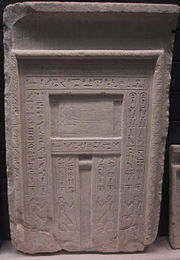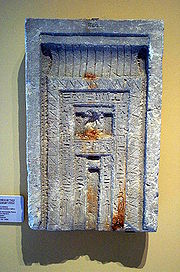
False door
Encyclopedia


Ancient Egypt
Ancient Egypt was an ancient civilization of Northeastern Africa, concentrated along the lower reaches of the Nile River in what is now the modern country of Egypt. Egyptian civilization coalesced around 3150 BC with the political unification of Upper and Lower Egypt under the first pharaoh...
. The ancient Egyptians believed that the false door was a threshold between the world of the living and the dead, and through which a deity or the spirit of the deceased could enter and exit.
The false door was usually the focus of a tomb's offering chapel, where family members could place offerings for the deceased on a special offering slab placed in front of the door.
Most false doors are found on the west wall of a funerary chapel or offering chamber because the ancient Egyptians associated the west with the land of the dead. In many mastabas
Mastaba
A mastaba, or "pr-djt" , is a type of ancient Egyptian tomb in the form of a flat-roofed, rectangular structure with outward sloping sides that marked the burial site of many eminent Egyptians of Egypt's ancient period...
, both husband and wife buried within have their own false door.
Structure
A false door usually is carved from a single block of stone or plank of wood, and it was not meant to function as a normal door. Located in the center of the door is a flat panel, or niche, around which several pairs of door jambs are arranged—some convey the illusion of depth and a series of frames, a foyer, or a passageway. A semi-cylindrical drum, carved directly above the central panel, was used in imitation of the reed-mat that was used to close real doors.The door is framed with a series of moldings and lintels as well, and an offering scene depicting the deceased in front of a table of offerings usually is carved above the center of the door. Sometimes, the owners of the tomb had statues carved in their image placed into the central niche of the false door.
Inscriptions
The side panels usually are covered in inscriptions naming the deceased along with their titles, and a series of standardized offering formulas. These texts extol the virtues of the deceased and express positive wishes for the afterlife.For example, the false door of Ankhires reads:
- "The scribe of the house of the god's documents, the stolist of Anubis, follower of the great one, follower of Tjentet, Ankhires."
The lintel reads:
- "His eldest son it was, the lector priest Medunefer, who made this for him."
And the left and right outer jambs read:
- "An offering which the king and which Anubis,
- who dwells in the divine tent-shrine, give for burial in the west,
- having grown old most perfectly.
- His eldest son it was, the lector priest Medunefer,
- who acted on his behalf when he was buried in the necropolis.
- The scribe of the house of the god's documents, Ankhires."
Historical development
The configuration of the false door, with its nested series of door jambs, is derived from the niched palace façade that became a common architectural motif in the Predynastic periodPredynastic Egypt
The Prehistory of Egypt spans the period of earliest human settlement to the beginning of the Early Dynastic Period of Egypt in ca. 3100 BC, starting with King Menes/Narmer....
and the Old Kingdom
Old Kingdom
Old Kingdom is the name given to the period in the 3rd millennium BC when Egypt attained its first continuous peak of civilization in complexity and achievement – the first of three so-called "Kingdom" periods, which mark the high points of civilization in the lower Nile Valley .The term itself was...
. The false door was used first in the mastabas
Mastaba
A mastaba, or "pr-djt" , is a type of ancient Egyptian tomb in the form of a flat-roofed, rectangular structure with outward sloping sides that marked the burial site of many eminent Egyptians of Egypt's ancient period...
of the Third Dynasty of the Old Kingdom
Old Kingdom
Old Kingdom is the name given to the period in the 3rd millennium BC when Egypt attained its first continuous peak of civilization in complexity and achievement – the first of three so-called "Kingdom" periods, which mark the high points of civilization in the lower Nile Valley .The term itself was...
, and its use became nearly universal in tombs of the fourth
Fourth dynasty of Egypt
The fourth dynasty of ancient Egypt is characterized as a "golden age" of the Old Kingdom. Dynasty IV lasted from ca. 2613 to 2494 BC...
through sixth dynasties. During the nearly one hundred and fifty years spanning the reigns of the sixth dynasty
Sixth dynasty of Egypt
The sixth dynasty of ancient Egypt is often combined with Dynasties III, IV and V under the group title the Old Kingdom.-Pharaohs:...
pharaohs Pepi I
Pepi I Meryre
Pepi I Meryre was the third king of the Sixth dynasty of Egypt. His first throne name was Neferdjahor which the king later altered to Meryre meaning "beloved of Rê."-Family:...
, Merenre
Merenre Nemtyemsaf I
Merenre Nemtyemsaf I was the fourth king of the Sixth dynasty of Egypt. His nomen, theophorically referring to Nemty, was formerly read as Antyemsaf, a reading now known to be incorrect.- Biography :...
, and Pepi II
Pepi II Neferkare
Pepi II was a pharaoh of the Sixth dynasty in Egypt's Old Kingdom. His throne name, Neferkare , means "Beautiful is the Ka of Re". He succeeded to the throne at age six, after the death of Merenre I, and is generally credited with having the longest reign of any monarch in history at 94 years...
, the false door motif went through a sequential series of changes affecting the layout of the panels, allowing historians to date tombs based on which style of false door was used.
After the First Intermediate Period the popularity of the false doors diminished, being replaced by stelae
Stele
A stele , also stela , is a stone or wooden slab, generally taller than it is wide, erected for funerals or commemorative purposes, most usually decorated with the names and titles of the deceased or living — inscribed, carved in relief , or painted onto the slab...
as the primary surface for writing funerary inscriptions.

